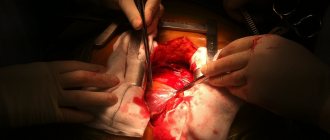Myocardial infarction is an acute form of coronary heart disease, resulting from a focus of necrosis of the heart muscle. Almost every patient who has suffered a myocardial infarction formally receives a disability, which is established taking into account the speed of restoration of normal body functions and the person’s subsequent ability to self-care, taking into account reduced functionality. Medical and social examination is based on clear criteria that make it possible to establish a disability group after myocardial infarction. The basis, first of all, is to determine the level of loss of opportunity for professional work after an illness.
Is disability allowed after a heart attack and stenting?
Myocardial infarction is a severe condition that is accompanied by ischemia and necrosis of a certain part of its muscle. This pathology is irreversible - dead cells will not be able to recover or grow again. It requires a long period of treatment and rehabilitation, which does not always lead to the restoration of normal organ function. Therefore, patients are entitled to disability (permanent or temporary). Also, patients often need to change professions, especially if their activities are associated with hazardous work.
Stenting is a minimally invasive operation performed with a special catheter, during which a section of the coronary artery is widened to improve blood supply to the myocardium.
Although this surgical intervention does not open the chest and subsequently does not require much time for rehabilitation, nevertheless, it may result in disability. This happens not due to the fact of the operation, but rather taking into account the disease that required the intervention.
Decision criteria: what determines the verdict
I draw your attention to the fact that absolutely all patients who have suffered a major heart attack have the right to four months of paid rehabilitation according to the certificate of incapacity for work. Only after this period has passed can you think about how to obtain a disability group.
Based on experience, I can say that about 40-50% of patients recover quite well over the elapsed period of treatment and can begin their professional duties if their work does not involve increased physical activity, but we will talk about this later. The rest of the patients, on the recommendation of the attending physician, can undergo examination by a medical and social expert commission to establish the fact of loss of ability to work.
This body evaluates the subject according to the following parameters:
- the possibility of self-service at home;
- ability to return to previous profession;
- patient education;
- general health indicators that will allow you to judge the degree of recovery after a pathology.
Taking into account the above, disability for myocardial infarction is given to persons who:
- performed work accompanied by frequent stress and requiring increased attention or excessive physical activity;
- have reached retirement age;
- have undergone surgical interventions on the coronary vessels (bypass surgery, stenting, etc.);
- have consequences of the disease (heart failure, unstable angina);
- have lost their ability to work by 50% or more;
- underwent rehabilitation for over 4 months.
It is necessary to understand that even if you are included in one of the categories, this does not guarantee that you will be assigned a disability group. Each case is considered individually by the commission and a large number of different factors are taken into account (comorbidities, complications).
Which group and in what case is it given?
In total, there are three groups of disability, one or another is formed not as a result of a heart attack, but against the background of complications that developed after it. The inspection procedure at MSEC is fixed by Government Decree No. 95 (dated February 20, 2006) .
The table lists the groups and examples of reasons for obtaining them.
| Third group | Assigned for 1-3 years if cardiac functions are slightly impaired and the patient, after treatment and rehabilitation, can begin his work duties. |
| Second group | Such a verdict is made in the case of consequences of a heart attack (malignant arrhythmia), when the patient’s recovery is poor and he will not be able to return to his previous place of work, but will be forced to change it. |
| First group | It is received by patients who are unable to care for themselves. They constantly experience pain, suffer from angina attacks, etc. |
What determines the length of a patient’s stay in a group in 2021?
For how long is disability assigned?
- Disability group 3 is established for a period of 1 year. At the end of the required period, the disabled person must undergo a second commission, which can either extend the validity of the group, or, if there is a positive trend, remove the group altogether.
- Group 2 is also established for a period of 1 year. At the end of this period, after passing a re-examination, the group is either extended or downgraded to group 3.
- Group 1 is initially assigned for 2 years. In this group, permanent disability is most often established, since the chances of full recovery are not very high.
Where to contact
The procedure for registering disability begins with a visit to the doctor, who will assess the degree of restoration of the function of the cardiovascular system after the end of treatment. If the specialist finds your condition satisfactory, he can close the sick leave and discharge you. The patient also has the right to contact the social security service.
Collecting a package of documents opens the door to receiving a referral to MSEC from the clinic at your place of residence - form 088/u-06. After which, by writing an application addressed to the boss and attaching the necessary originals and copies, you can go to the examination bureau. There you will be given a date for an examination, at which the commission will decide on the presence or absence of signs of disability. The verdict is usually communicated orally and a written report is issued.
Expert advice
To avoid getting false hopes and wasting time on paperwork, first talk to your doctor about your chances of receiving disability.
Only he sees the dynamics of the rehabilitation process, and also has the necessary experience in this matter. I draw your attention to the fact that MSEC members have the right to request additional research and invite specialized specialists to clarify the patient’s condition. A patient can do the same, but he will just have to pay for it himself.
List of documents
For this procedure you will need the following documents:
- passport;
- referral to MSEC (form 088/u-06), issued by the attending cardiologist or social security service;
- a patient's card from the outpatient clinic, extracts from the hospital and other medical documentation that fully confirms the diagnosis and describes the health status of the subject;
- a statement written to the head of the examination bureau;
- a copy of the work book, certified by the seals of the organization in which the patient works;
- a detailed description of working conditions from the place of work and a list of the patient’s responsibilities;
- If available, a pension insurance policy is also included.
What group can you get?
The commission makes a decision on whether disability is due after a heart attack and stenting based on a comprehensive examination of the patient. Depending on the degree of heart damage and consequences, the first, second or third group can be assigned. Each provides its own privileges in terms of work and preferential financing.
First disability group
The ability to independently serve one’s needs has been lost by 80-95%. People with such a percentage of heart attack lesions are considered disabled.
For this form of the disease, the following benefits are prescribed:
- social pension;
- free travel on buses, trams and trains;
- free medicines;
- spa treatment once a year;
- working week no more than 35 hours;
- exemption from payment of transport tax and real estate tax;
- 50% discount when paying for housing and communal services (if there is more than one apartment, then to choose from).
Second disability group
The second degree is assigned to moderate heart attacks. Such people can perform their labor function only if favorable conditions are created, both physical and psycho-emotional.
Almost all the same preferences apply here as for people with group I. The only exception is in terms of providing medications: for some medications you will have to pay 50% of the cost.
Third disability group
Group III disabled people are entitled to:
- 50% discount on the purchase of medicines;
- 50% discount on utility bills;
- social pension;
- free travel on public transport;
- up to 60 days of vacation at your own expense.
Depending on the degree of complications, you can count on a free nurse. But if relatives live in the house with the patient, they will first have to prove that they themselves cannot perform the functions of care. To do this, the social security authority will need to provide proof of employment confirming full-time employment.
Legitimate reasons for refusal
Keep in mind that MSEC may legally refuse to obtain disability. This happens if:
- treatment and rehabilitation of the patient have been carried out to a sufficient extent, which prevents the possibility of relapses or complications;
- the patient is fully able to work and can fully care for himself;
- the specialty of the certified person does not require significant psycho-emotional stress, concentration or change of place of work.
In case of refusal, the patient has the right to re-apply to the examination bureau for examination in the same manner. If even after this the disability group is not assigned, you can submit documents to the Federal MSEC body, and then to the court.
Re-examination procedure
Re-examination for a disability group is a voluntary exercise and can be prescribed by mutual decision of the patient and the attending physician. The referral reflects the treatment procedures prescribed during the rehabilitation period and makes a conclusion about their effectiveness (they helped, helped slightly or did not help).
The rest of the list of documents is the same as for the initial application. It should also be accompanied by a certificate of the current disability group and an individual rehabilitation program developed by the previous commission. The rehabilitation card must indicate that you have completed all stages of treatment, otherwise you will definitely not be given a new group.
If the rehabilitation program specifies requirements for the work regime, you will need to contact the employer for a mark of completion and a signature on compliance with the prescribed conditions.
Professions that become prohibited after a myocardial infarction
After a myocardial infarction, there is a group of professions that are not recommended for patients, as they increase the risk of relapse of the disease or the appearance of its complications. This may include:
- work associated with prolonged physical activity (walking, standing) - sellers, couriers, postmen;
- work in airlines - flight attendants, pilots, flight attendants;
- specialties that require intense cognitive functions (attention, thinking) - drivers, crane operators;
- professions that involve night shifts and a daily schedule.
Also, those who were associated with harmful production conditions (metallurgy, mining, etc.), or rotational duty, located at a distance from populated areas, will have to change their place of work.
Preferential preferences for people with disabilities due to heart attack
The law does not provide any separate benefits for those disabled people who have been assigned a group due to a heart attack. They can enjoy all the privileges that the assigned group gives them.
This usually includes:
- Registration of a disability pension;
- EDV payment, which occurs monthly. In addition to the monetary amount, the EDV also includes in-kind services, which, if desired, can also be replaced with payments.
- Refund of 50% of paid utility costs;
- The Labor Code establishes a more gentle work schedule for disabled people - shorter working hours, longer vacations, a ban on being hired to work on weekends, on business trips, etc.
- Benefits for tax payments, and in some situations - complete exemption from them;
- Travel on city municipal transport is free, or with compensation of part of the expenses;
- Providing free medications, prostheses, or discounts on their purchase.
Clinical case
Patient G., 55 years old, was admitted to the emergency department with complaints of intense, burning pain in the chest, which radiated to the lower jaw and left arm, as well as fear of death.
Taking nitroglycerin did not reduce the discomfort. History: angina pectoris, diagnosed 5 years ago, prescribed therapy was taken irregularly. Objectively: pale skin, hyperhidrosis, heart rate 100 beats/min, severe shortness of breath at rest, cyanosis of the nasolabial triangle, third and fourth heart sounds appeared, blood pressure 160/100 mm Hg. Preliminary diagnosis: “Myocardial infarction.” The diagnosis was confirmed using: dynamic ECG, blood test for markers of infarction (troponins T and I, CK, CF-CK), clinical and biochemical blood tests, Echo-CG. The patient received: “Actelise”, “Aspirin-cardio”, “Heparin”, “Morphine”, GIK, “Bisoprolol”, “Erinit”, “Preductal”, “Quercetin”.
After treatment and a four-month course of rehabilitation, the patient still had swelling in his legs, shortness of breath at rest, and attacks of angina, so he was referred to MSEC. After the examination procedure, he was assigned disability group II for a period of 1 year.











